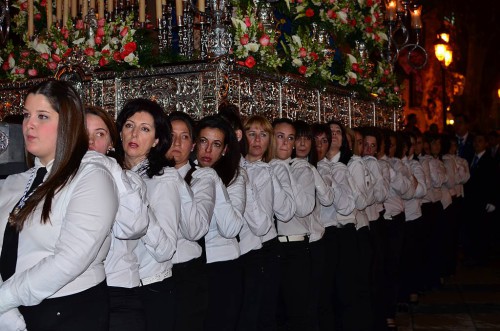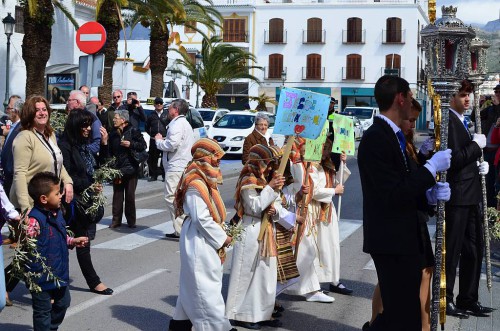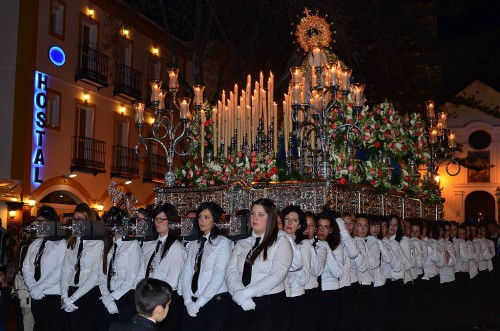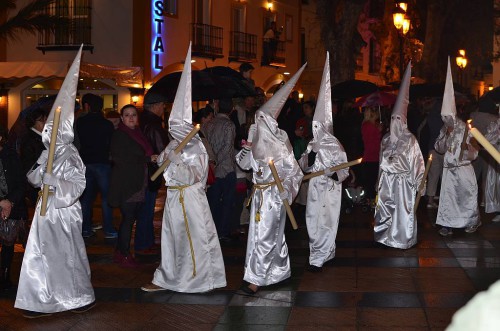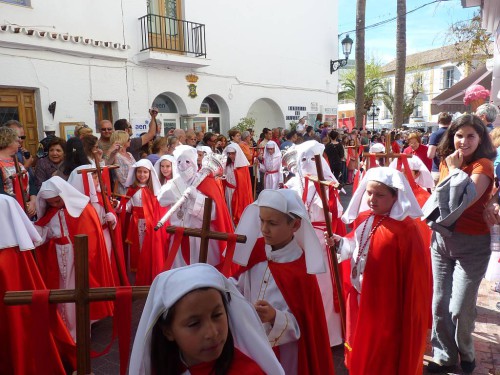Easter / Semana Santa / Holy Week
Spain is slowly drifting towards a secular society, with many young people largely ignoring their Roman Catholic heritage, but Semana Santa, Holy Week, is still very much celebrated throughout the country.
The ancient rituals, celebrating the death and resurrection of Jesus Christ, are a sight not to be missed. Often to the solemn, persistent beat of a single drum, men wearing pointed hoods (capirote) parade through the streets bearing huge crucifixes, whilst women dressed in black stand in silence and watch. The pointed hoods, reminiscent of those worn by the Ku Klux Klan, represent penitents (nazarenos) too shamed by the crucifixion to show their faces.
Palm Sunday – Domingo de Ramas – is the start of Holy Week and most churches will organise a parade to mark the arrival of Christ into Jerusalem. Huge, leafy palm or olive branches, blessed in the church, will be carried through the streets. Many towns and villages will host parades every evening, starting at the local church.
Each procession is preceded and followed by penitents clad in tunics of varying colours, some also wearing a mask (antifaz) to hide the identity of the penitent. Huge images and statues depicting the story of Holy Week are carried on heavy floats (tronos) by groups of bearers (costaleros.) They are led by the capataz, whose duty it is to direct their steps as they wend their way through often narrow, crowded streets.
The floats sway from side to side, and the smell of burning incense and candles fills the air. Some parades are accompanied by music, some by a single, hypnotic drumbeat, and some maintain an eerie silence. The processions (pasos) are the responsibility of the various religious brotherhoods (cofradias) and some may organise as many as three pasos, representing Christ, the Virgin and a scene from the Passion.
Rituals vary from one region to another, some being unique to a particular town, some being quite extreme in nature. In San Vicente de Sonsierra in Rioja, a form of flagellation is still carried out on Good Friday by one of the religious brotherhoods . The ritual is technically outlawed, although that doesn’t seem to bother anyone and it draws crowds of curious onlookers every year.
In Valverde de la Vera, in Caceres, men wearing crowns made out of thorny branches walk in bare feet along a symbolic path to Calvary, their arms tied to a wooden bar onto which heavy swords are hung. In Madrid, people dressed in the medieval garb of penitents, including iron shackles, carry one of the images from the church around the city.
Sevilla is where one of the most famous Easter celebrations takes place. Sevilla has a total of 52 religious brotherhoods whose members take part in parades starting at first light each day and continuing until three or four in the morning.
The origins of these brotherhoods dates back to as early as the 13th century when they were bands of men organised to rescue the wounded from battlefields during the re-conquest of Spain from the Moors. Each brotherhood has its own penitents’ garb, varying from rich satin and brocade to plain black.
Ornately carved wooden floats, many dating back to the 17th century and weighing up to 2000 kilos, are carried through the streets by costaleros. Drums and trumpets accompany the procession until, arriving at the Gothic cathedral, the journey ends in solemn silence. Easter Sunday sees a change in mood to one of jubilation.
The floats are covered with flowers, traditional sweet cakes such as monas, torrijas and pestihos are eaten and the final parades are played out to triumphant music.
Nerja
Palm Sunday: Procession of palms and olives representing the arrival of Christ in Jerusalem.
Wednesday evening: The recently-formed (1998) Cofradía Infantil de Nuestro Padre Jesús Cautivo y María Santísima de Los Desamparados(Children’s Guild of Our Father Jesus held captive and Holy Mary of The Defenceless) carry two small floats through the town.
Thursday: Nazarenos, dressed in purple with white cloaks, accompany the float bearing the image of Jesús Nazareno, followed by a second float with the image of the Virgen de La Esperanza. A unique aspect of this parade is that it is preceded by hundreds of women dressed in mourning. The procession is organised by La cofradía de Nuestro Padre Jesús Nazareno y María Santísima de los Dolores.
Good Friday: The first float carries Jesús Yacente (Jesus lying in state) and the second, the Virgen de Dolorés el Viernes. The procession is organised by La Hermandad de Jesús Nazareno.
Saturday: Vigil in the El Salvador church, starting at 11.00pm.
Easter Sunday morning: Three floats, decorated with red and white roses, celebrate the Resurrection. Clothing is white with a red cloak.
The Easter week processions compete with one another in luxury and splendour. The parades start in the local church and slowly wind their way through the town.
The centre-piece of the processions are the life-like statues of Christ on the Cross and his mother the Virgin Mary in mourning. The processions are organised by the religious brotherhoods, representing guilds of tradesmen or other groups.
They spend all year long preparing the elaborate costumes and decorations. This is a serious fiesta so firework displays are not permitted and drinking and celebrating are still frowned upon by many.
Yopu will find lots of photos in the Photo Gallery
You will find more videos of the various Easter processions on our YouTube channel under ‘Fiestas’

